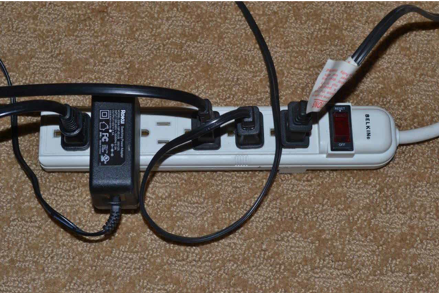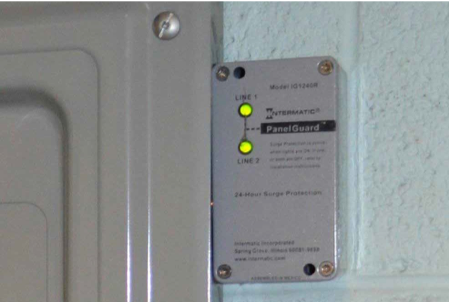
Guidelines for providing surge protection devices (SPDs) at commercial, institutional, and industrial facilities
When it comes to losses of electrical and electronic equipment, few events can match the destruction caused by surges (transients) and electrical noise. These phenomena are responsible for about 50 percent of most electronic equipment failures today. This does not include the latent damage or degradation to electrical equipment caused by surges.
Since microprocessor-based equipment functions with faster operating speeds and lower operating voltage than other equipment, surges and electrical noise previously classified as non-threatening are significantly more damaging. The estimated annual cost for damages and lost revenues associated with these problems is in the millions. A facility owner can greatly reduce the risk of equipment damage, component degradation and system disruptions with a robust surge protection system.
An electrical transient is a short-duration, high-energy impulse that is imparted on the normal electrical power system whenever there is a sudden change in the electrical circuit. They can originate from a variety of sources, both internal and external to a facility.
The most obvious source is from lightning, but surges can also come from normal utility switching operations, unintentional grounding of electrical conductors (such as when an overhead power line falls to the ground). Surges can also enter the premises via internet cable and telecommunications lines. However, numerous studies have shown that exterior sources account for only 20 percent of all electrical surges. The remaining 80 percent can be accounted for by equipment within a facility. Known sources of transients and noise within a building or facility include everyday things such as fax machines, copiers, air conditioners, elevators, motors/pumps, or arc-welders. In each case, the normal electric circuit is suddenly exposed to large doses of energy that can adversely affect the equipment being supplied power.
Surge protection basics
A surge protection device (SPD), previously known as a transient voltage surge suppressor (TVSS), is designed to absorb and divert high-current surges to ground and bypass your equipment. This action limits the voltage that is impressed on the equipment. The backbone of every SPD is the metal oxide varistor (or MOV). The MOV is a solid-state device that normally has very high impedance. When the applied voltage suddenly exceeds the “breakdown voltage,” the MOV acts as a very high-speed switch and diverts the energy to ground. An important aspect of the SPD is that it is a sacrificial device with degradation of performance over time. It is considered to be at the end of its life when it has lost 10 percent of its design capacity. When selecting an SPD, there are many features to consider, including remote annunciation capabilities, audio alarms, and indicator lights. A very important feature is a diagnostic indicator (visual, audible or otherwise) to verify that it is still functioning and hasn’t been disabled from the last surge suppression event.
Installation
Only surge protection that is properly sized and grounded can be successful in preventing equipment damage. For maximum protection, SPDs should be installed as close to the protected equipment as possible, and cable lengths should be as short and straight as possible to minimize the resistive path of the circuit to ground. Anything less than a low grounding and bonding impedance will cause surge energy to be diverted throughout the facility with potentially hazardous effects. The National Electrical Code (NEC®), NFPA-70, Article 285 provides details on the proper installation of SPD devices. NEC Article 250 provides details on proper grounding of your electrical system. It is highly recommended that a licensed electrician be retained to ensure that your SPD is properly installed and grounded.
Grounding is essential
Three key points must be addressed regarding grounding and bonding.
- Evaluate your facility’s grounding for NEC compliance. All outlets should be checked for proper polarity and impedance that should be less than 1 ohm.
- Determine if the grounding system is robust enough to fulfill the function of the SPD, i.e., proper wire size and tightness of connections.
- Determine specific corrective action required to bring the grounding network to both NEC compliance and to the level of performance to address transients and electrical noise.
Zones of protection

Photo courtesy of HSB
IEEE Std 1100—IEEE Recommended Practice for Powering and Grounding Sensitive Electronic Equipment (also known as the IEEE Emerald Book®) presents recommended guidelines for design, installation, and maintenance practices for electrical power, grounding and protection of sensitive electronic loads such as computers, servers and other susceptible electronic equipment used in commercial and industrial applications.
One of the primary recommendations set forth in IEEE 1100 is the implementation of “Zones of Protection.” Considering that surges can originate from both internal and external sources, SPDs should be installed to provide maximum protection regardless of the source location.
The three zones include:
- The first zone is at the service entrance where the most robust SPD is placed to divert surges coming from external sources. SPDs installed here are listed as Category “C” devices.
- The second zone of protection is within the facility at locations identified as susceptible to surges. SPDs at these locations are listed as Category “B” devices and are installed on equipment such as switchgear, panel-boards, and branch circuit panels.
- The third zone of protection is at the outlet, or point of use. SPDs installed here are listed as Category “A” devices.
It is strongly recommended that a professional engineer, experienced with surge suppression technology, be retained to design the protection system for your facility to ensure all SPDs are properly sized and coordinated.
Coordination of SPDs

Each zone of protection adds to the overall protection of the facility as each helps to further reduce the voltage exposed to the protected equipment. While the service entrance SPD provides the first line of defense against electrical transients for a facility by diverting high-energy, outside surges to ground, it also lowers the energy level of the surge entering the facility to a level that can be handled by downstream devices closer to the load. Therefore, proper coordination of SPDs is required to avoid damaging SPDs installed on distribution panels or locally at vulnerable equipment. If coordination is not achieved, excess energy from propagating surges can cause damage to Zone 2 and Zone 3 SPDs and destroy the equipment that you are trying to protect.
Standards for SPDs
Standards that are useful in evaluating SPDs include, but are not limited to:
IEEE Std. C62.45—this standard provides the surge testing procedures, and a means of measuring the performance characteristics for surge-protective devices used in low-voltage ac power circuits.
NEMA-LS1—is the manufacturer’s standard and specification guide for low voltage AC power SPD applications.
NFPA 780—is the standard for Lightning Protection Systems.
UL1449—is the safety standard for all surge protection equipment installed on low voltage AC circuits. It is a safety standard, and not a performance standard. (NEMA LS-1 is the manufacturing performance standard.)
Note: any statement that an SPD “meets the requirements of C62.41” is inappropriate and misleading. IEEE Std C62.41 has been superseded by IEEE Std C62.41.1 and C62.41.2. These two standards describe the surge environment and establish standardized waveforms; they are not testing or performance standards
Typical costs
Depending on the application and ratings, SPDs for service entrance equipment range from $500–$6500. Data line and AC receptacle protection ranges from $25–$150.
Summary
Although surges and electrical noise cannot be totally eliminated, they can be mitigated through an engineered approach thereby reducing their damaging effect. This leads to greater reliability and overall improved productivity. In this regard, surge protection really is an inexpensive form of electrical system insurance.
To learn more about Hanover Risk Solutions, visit hanoverrisksolutions.com
Copyright © 2014 The Hartford Steam Boiler Inspection and Insurance Company. All rights reserved.
The recommendation(s), advice and contents of this material are provided for informational purposes only and do not purport to address every possible legal obligation, hazard, code violation, loss potential or exception to good practice. The Hanover Insurance Company and its affiliates and subsidiaries ("The Hanover") specifically disclaim any warranty or representation that acceptance of any recommendations or advice contained herein will make any premises, property or operation safe or in compliance with any law or regulation. Under no circumstances should this material or your acceptance of any recommendations or advice contained herein be construed as establishing the existence or availability of any insurance coverage with The Hanover. By providing this information to you, The Hanover does not assume (and specifically disclaims) any duty, undertaking or responsibility to you. The decision to accept or implement any recommendation(s) or advice contained in this material must be made by you.
LC FEB 2019-408
171-9308 (1/19)
